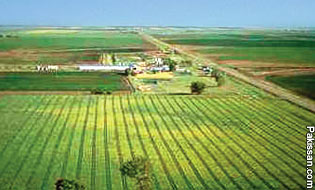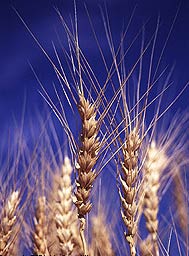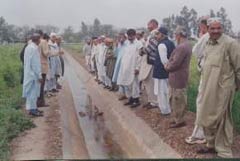|
Farm sector's neglect adding to rural
distress
By M. Shafi Niaz
Despite favourable farming
conditions, Pakistan until two-three years back was not
producing sufficient wheat to meet the domestic requirements.
On an average, 2.5 million tons of wheat was imported every
year.
 But during the last couple of years, production has surpassed
the needs thus taking Pakistan into the export market. However
higher cost of production and incidentals did not allow the
wheat a competitive edge; so its exports were heavily
subsidized. But during the last couple of years, production has surpassed
the needs thus taking Pakistan into the export market. However
higher cost of production and incidentals did not allow the
wheat a competitive edge; so its exports were heavily
subsidized.
The government has decided that irrespective of the domestic
production and demand, half a million tons of wheat should be
exported every year to keep the country in export business,
because it is difficult to find fresh markets in years of
surplus production.
In view of the expected low production of the crop harvested
in spring 2004 the export is temporarily banned. Other items
being imported are edible oils (about 85 per cent of the
domestic requirements), tea and wood products, and powdered
milk.
Sugar, like wheat has always been on the import list, but
recently it has accumulated some surpluses, which are being
exported by providing subsidies because the international
prices were lower than our prices owing to high cost of
production. The position would become different if
international prices improve.
Agriculture is a gamble in nature. Its performance is
influenced by the natural calamities, sometimes quite
significantly like the temperature, rainfall, drought, storms,
hailstorms, insect and disease attack, floods and so on.
On account of these and other factors, the yield in many cases
does not equal to the world average. It is somewhat lower than
in an adjoining country where agriculture is being practised
with heavy subsidy due to the use of fertilizers and better
infrastructure facilities.
One of the major factors is that the farmers generally don't
get the cost incurred on production, or more, which could
motivate them not only to grow the crop but also to raise
production.
 Another factor is inefficiencies in the marketing system,
which don't permit the farmers to reap what they should,
affecting their net income - factor influencing the poverty
level. Another factor is inefficiencies in the marketing system,
which don't permit the farmers to reap what they should,
affecting their net income - factor influencing the poverty
level.
The government, on the recommendations of the World Bank,
instituted the Agricultural Prices Commission (APCom) in 1981
to recommend the support price of a dozen of crops.
This was to safeguard the farmers' interest, particularly in a
good crop year when post-harvest prices fall to a level
against the interest of farmers. This system of fixing support
prices worked satisfactorily for over a decade or so.
In recent years, the same World Bank along with other
international loaning agencies has been advising the
government to do away with it for enabling the market to
determine the price level depending on supply/demand
situation.
This made the farmers to agitate. The President of Pakistan
constituted a Committee which submitted its recommendations.
The Cabinet despite opposition from the ministries of finance
and commerce, decided that the support price of wheat, cotton,
rice and sugarcane should continue.
However, the finance minister in his 2002-2003 budget speech
announced to keep intact the support price of wheat and cotton
only - implying that there would be no support price for other
crops.
The first Cabinet meeting held under the Chairmanship of Prime
Minister Mir Zafarullah Khan Jamali decided to announce the
support price of all crops (Kharif and Rabi) about two months
before their sowing times.
Presently, support price of cotton and wheat only are being
announced, and that too, not before sowing. In the case of
rice crop "indicative" price has been announced which
practically has no meaning after sowing. The price of
sugarcane was left to the discretion of the provincial
governments and only "indicative price" was announced by the
federal government.
Another factor is the continuous rise in input prices. Again
under the pressure from international organizations the
government withdrew subsidies on agricultural inputs. As if
this was not enough, the government also levied sales tax on
fertilizers to raise revenues.
The economic analysis done by experts shows that the revenue
realized from the sales tax was far less than the loss of crop
in value terms because of the shortfall in production due to
the low use of fertilizers on account of exorbitant prices.
What a policy? In addition to substantial increase in
fertilizer prices, which accounts for over 20 per cent of the
cost of wheat production, there have been substantial
increases in the POL costs, labour, harvesting and threshing
charges.
The support price, which was fixed at Rs300 per 40kg for the
1999-2000 wheat crop, remained in force for four years till it
was revised to Rs350 per 40kg for 2003-04 crop, adversely
affecting the farmers' income. This contributed to the poverty
graph.
It is pertinent to mention that although Pakistan withdrew the
subsidy on fertilizer, India is still providing to the extent
that they allocated about Rs14,170 crore in their 2002-2003
budget which was raised from Rs13,800 crore in the previous
year.
Similarly in the US, the Senate approved $275,000 per farm
crop on agricultural subsidies. The farmers could receive
under the existing rules unlimited subsidies for producing
grain, cotton and soybean.
 The European countries are also providing huge subsidies to
their farming communities. Pakistan can not have a competitive
edge under such situation where cost of production is going up
but farmers are not being compensated in the output prices. The European countries are also providing huge subsidies to
their farming communities. Pakistan can not have a competitive
edge under such situation where cost of production is going up
but farmers are not being compensated in the output prices.
There are also marketing inefficiencies prevalent in the
system. In wheat export, it was revealed that the incidental
cost from purchase to export were as high 20-25 per cent of
the support price.
This resulted in high export subsidies which prompted setting
up of the committee to study marketing system and suggest how
to reduce costs. The report submitted at the end of 2002 does
not seem to have been considered because of change in the
government.
The input-output price has to be rationalized, particularly
when the country has to follow the WTO rules. Under the WTO
regime there would be no restrictions on the import and export
of commodities and on tariff, therefore, quality and price
would be governing factors in international trade.
If commodities, cheaper than the domestically produced, make
way into Pakistan then our agriculture is bound to suffer. The
flooding of local markets with cheap wheat, sugar, edible oils
and other usable commodities would have devastating effects on
the agriculture sector. This will negatively effect the income
of particularly, small farmers.
Crops like sugarcane do not have a competitive advantage when
seen from the export point of view. The domestic resource
cost, though varies from year to year, still remains much
higher as compared to its competitive crops like cotton and
rice.
Having been given protection through banning cheaper imports,
this industry has expanded and in a very small span of time,
the number of sugarmills has grown to around 74.
Presently, not more than half of the installed capacity of
these sugarmills is being utilized. Once cheaper sugar enters
into our market, the industry would face serious problems for
its existence which in turn would impact on cane growers who
will feel the brunt of low prices for their crop.
Edible oil is on the top of importing list, putting pressure
on foreign exchange. The government made a good start to raise
oilseed production but the enthusiasm phased out after
mid-nineties.
Thereafter, it received low priority. The non-traditional
crops, viz, sunflower, canola and soyabean were allowed to be
guided by the free marketing mechanism. Private sector, in the
hope of increased production expanded the solvent extraction
industry. But, as the pace of production was much below than
their expectations, the industry remained under-utilized. The
entire edible oilseed and marketing sector needs a thorough
probe to identify areas where improvements could be effected.
Any increase in oilseeds production would benefit country in
the sense that the huge foreign exchange burden would be
reduced. Moreover, as these crops can be successfully grown in
un-irrigated areas, it would help improve the income of
farmers in these dry tracts.
The government plans to promote tea cultivation in the NWFP to
help inhabitants raise their incomes. For this, in 1986 a Tea
Research Station at Shinkiari, Dist Mansehra was set up which
succeeded in planting about 100 acres of tea, so far.
A processing plant has also been obtained from China. The plan
initially will extend plantation to 150,000 acres by the
private sector. In addition, the Lever Brothers have also
shown interest in tea cultivation, and so far they have
succeeded in planting tea on 400 acres, to be extended to 1500
acre.
They have also set up a processing plant at Mansehra but for
the lack of tea leaves, utilization of the plant is not more
than one fifth of its capacity. It is learnt that their
efforts have not been successful and that they were planning
to give their plans up.
However, some experts are doubtful if tea cultivation would be
economical in these areas and whether it would have
competitive advantage to grow in the face of the WTO regime
soon coming into operation, when customs free imports of tea
could take place from the conventional countries like
Bangladesh, Sri Lanka, Kenya and India.
There are at least four factors, which experts think should be
taken into consideration. It needs acidic soils, but many of
the soils in areas where tea plantation is planned are not
acidic, and therefore, may have to be brought to the desired
level. This would need cost.
Second, tea plants need frequent and timely rainfall, but in
planned areas rainfall is irregular. Therefore, sprinkler
irrigation may have to be adopted. Moreover, tea plants do not
like water to stand in fields; it must be drained off.
All areas under consideration do not have adequate slope for
natural drainage of water. Moreover, temperature during summer
is quite high, which adversely affects the quality of tea.
And lastly, as it takes 3-4 years before tea can start giving
any returns, the farmers would need credit to tide over this
period. All these factors would add to the cost of cultivation
and, therefore, need to be considered to determine if it would
be economical to grow tea domestically before farmers are
advised to resort to it. Moreover, comparative advantage
vis-a-vis other countries from whom we import tea is a factor
to be reckoned with.
The problem of water-logging and salinity is serious.
According to the Agricultural Statistics of Pakistan (Minfal),
just after the monsoons i.e., in October, about 3.2 million
hectares are such where water table generally is between 0 to
5 inches while 6.3 million hectares are such where water table
is between 0 to 10 inch from the upper surface of soil. The
corresponding figures before rains i.e., June, is 544,000 and
2.4 million hectares. As regards the salinity, about 3 million
hectares of the cultivated area are affected by saline sodic
salts.
This is prevalent mostly in Punjab (1.5 million hectares),
Sindh (1.2 million) and very little in Balochistan and the
NWFP. This is one of the reasons for low land productivity,
thus affecting incomes of farmers.
With the foreseen shortage of water, these twin menaces are
likely to increase rather than decrease. Very serious and
concerted efforts are needed to arrest this likely trend, so
that the farming community is not affected.
There are about 550,000 tubewells in the country, of which
about 87 per cent are in Punjab. Of the total, more than three
fourth are operated by diesel. The cost of diesel has
gradually gone up to much more than double what it was 3-4
years ago.
Because of drought conditions, farmers have been over-pumping
water from the subsoil for irrigation purposes. The result is
that water of a very large percentage (according to one
estimate more than 90 per cent) of the tubewells has gone
saline and is becoming unsuitable for irrigation, and if its
use is not rationalized, it would adversely affect the
suitability of land for cultivation.
This would also have deteriorating effect on land
productivity, thus limiting chances for improving the output
per unit of land and income of farmers. Water is life for
plant growth.
About 80 per cent of our cultivated area of 2.1 million
hectares is irrigated by canal water which is supplied mainly
from the Tarbela and Mangla dams, one of the biggest dams in
the world constructed in 1960's and 1970's, respectively.
The designed capacity of both these dams was 15.05 million
acre feet. Because of indiscriminate felling of trees and
denudation of vegetation resulting from over-grazing,
particularly in the watershed of these dams, the capacity had
almost reduced to 12.76 million acre feet by 2003, a fall of
about 15 per cent, and is likely to further reduce to 11.50
million acre feet by 2010, i.e., reduction of about 23.6 per
cent from the designed capacity.
Concerted and continuous efforts are required for effective
and efficient watershed management for these dams, if further
silting up is to be restricted. Past efforts have not shown
any tangible results except some success attained in the
Mangla watershed.
With the passage of time, water shortage is becoming a global
problem and Pakistan is no exception. The situation in
Pakistan got worsened because of the continuous drought during
the last three or four years.
The construction of Kalabagh dam to supplement the dwindling
irrigation supplies has become the victim of provincial
politics. According to irrigation experts, this is a desirable
project as shown by feasibility studies carried out by the
international organizations.
However, early solution to this conflict seems the urgency of
the day. Our world-renowned irrigation experts estimated that
it would need some 750 small dams to store water equal to the
planned capacity of Kalabagh dam.
It is heartening to note that the President of Pakistan has
recently taken a firm stand that the construction of Kalabagh
dam or Bhasha dam (if its feasibility so demands) would start
from 2004, but before this is done, consensus of the provinces
have to be sought.
In the looming days of water shortage, there is a need to
change the cropping pattern of crops, from high delta ones to
low delta ones, change in methods of surface irrigation,
adoption to sprinkler irrigation system, levelling of land to
economize the use of water, zero tillage of crops, where
possible, and so on.
The wastage of water from the canal heads to fields which is
about 40 per cent or so, has to be reduced for which attention
is needed. To reduce these losses for which more research and
allocation of resources is required.
Livestock is an important sub-sector as it contributes about
40 per cent to the agriculture sector, and about 10 per cent
to the country's GDP. It provides livelihood to about 30
million people and contributes substantially to foreign
exchange earnings.
It provides supplementary income to rural people. This
sub-sector has not, in the past, received attention of the
government, which it deserves as is manifested in the
allocation of resources in the Five-Year, as well as, the
Annual Development Plans to this sub-sector.
The Dawn
|
Pakissan.com;
|